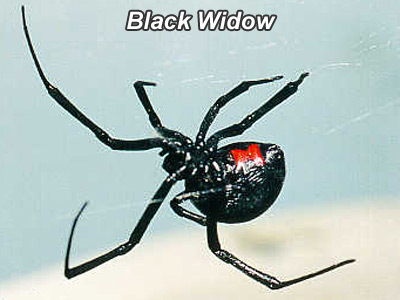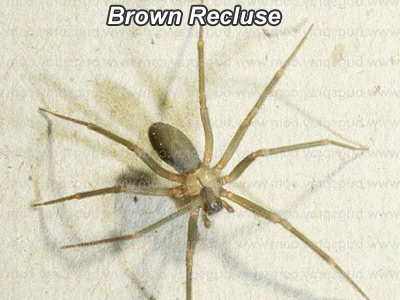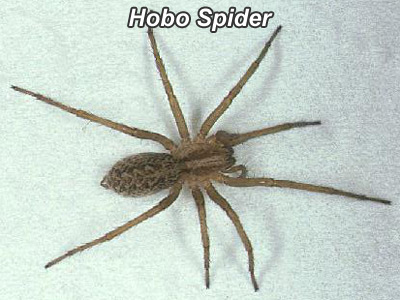Dangerous Spider Identification
Tips For Correctly Identifying Spiders - There are around 4,000 species of spider that have so far been identified in the United States, and with so many of these small animals there are a few distinctive features that help them to stand out. Although many scientists will be interested in separating each individual species, the majority of people will really be interested in identifying those spiders that can be dangerous from those that are completely harmless.
People constantly misidentify spiders. Because there are so many species and genuses, there's no good way to narrow it down by characteristic. Thus, I'm just going to do a description of the most common dangerous species of spider, which can harm people with venomous or poisonous bites. If it's not one of these, it's harmless.
 | |
Identifying The Black Widow
The Black Widow is a particularly notorious species of spider because of its potent venom, but the reality is that most people will only be identifying the female of the species, as she is much larger than the male and is much easier to spot. The female black widow is around an inch and a half in length with distinctive markings on the body of the spider. The body itself is black and shiny, with a bright red marking, often in the shape of an hourglass or as two red spots. The rear segment of the body is usually significantly larger than the front part of the Black Widow's body.
It is worth noting that one species commonly mistake for a Black Widow is the Steatoda Grossa, although it is commonly known as the False Black Widow. The main feature to look for is that although the False Black Widow will often have a shiny black body of similar shape, it won't have the distinctive red markings on the body.
|
 | |
Identifying The Brown Recluse Spider
Another spider that many people will want to know how to identify is the Brown Recluse spider, although it is also often referred to as the Violin spider because of a distinctive marking. The thing to look for is a brown violin shape on the back of the spider's head, and this is generally darker than the rest of the body. The spider itself is likely to range from a tan to brown color, and if you can get a good look safely then it is also distinctive because of the fact that it has only six eyes, and because of the long thin legs that do not have any spines.
The brown recluse spider can sometimes be mistaken for cellar spiders or pirate spiders, but in the case of a spider bite it is important to try and trap the spider in a clear container to examine the number of eyes. This is the real diagnostic test as other spiders can bear similar markings.
|
 | |
Identifying The Hobo Spider
The hobo spider is generally to be found in the north west of the United States, and is often identified incorrectly as the Brown Recluse because of the severity of the bite. When it comes to identifying the hobo spider, look for the distinctive v-shaped pattern with a number of v-shapes down the back of the spider's
abdomen pointing towards the head. Because it creates funnel shaped webs, it also has two spinnerets extending from the bottom of the abdomen.
There are dark lines on the thorax. Basically, it's the spider you see to
the left.
It's about the size of a quarter, a little bigger, with the
legs and all. The abdomen can be fatter or thinner than in this picture,
but it'll always have that pattern of triangles on it. |
Identification Of Other Spider Species
With over 4,000 individual species of spiders having been identified in the United States, identifying spiders is often a case of elimination, examining a number of different factors until a match is found. The first area which can be used for the identification of a spider species is the eyes and mouth of the spider. There are a variety of different types of format for the head of a spider, with the number of eyes, location of eyes and the mouth all being vital in identifying the species of spider.
When it comes to the definitive identification of a spider, the best solution is to capture the animal if possible and then to take it to an expert to identify. Because these are very small creatures it will often require a magnifying glass or even a microscope in order to make certain of the identification. However, along with the visible markings on the spider, when this is combined with the location where the spider was found it can be possible to be fairly certain of the species.
Unidentified Species Of Spider
The majority of species of spider in the United States are fairly small and are not particularly dangerous to humans, but it is believed that there are many species of spider around the country that are still to be identified. The majority of these species are those that will rarely come into contact with people, such as the recent discovery of the Trogloraptor spider in Oregon, which is three inches in length and has legs mounted with sharp claws and feet. As with any animal, if you do not know what it is the best course of action is to be cautious and to leave the spider alone unless it is safe to take a picture or make a positive identification.
Some of my other spider pages:
Brown Widow Spider - information and photos.
How to Treat a Spider Bite
How To Get Rid of Spiders
|